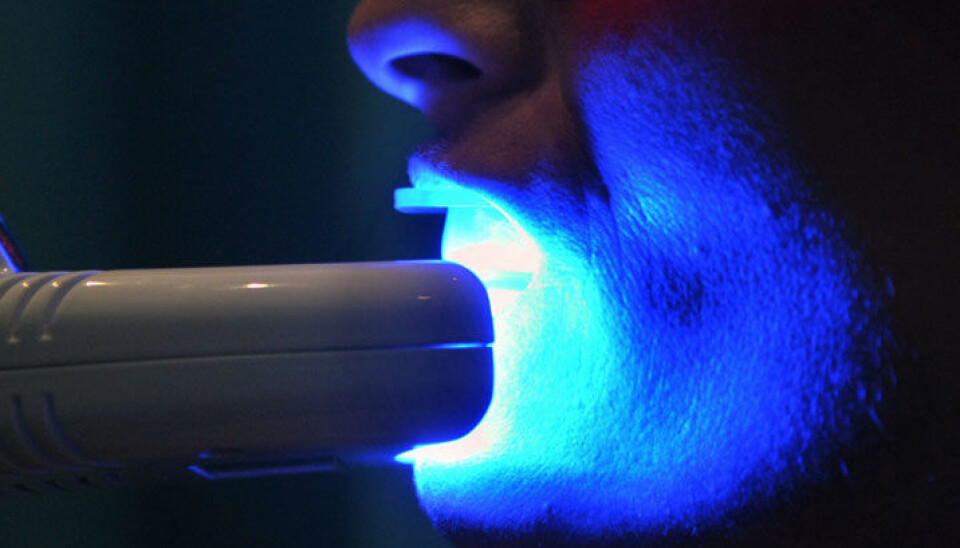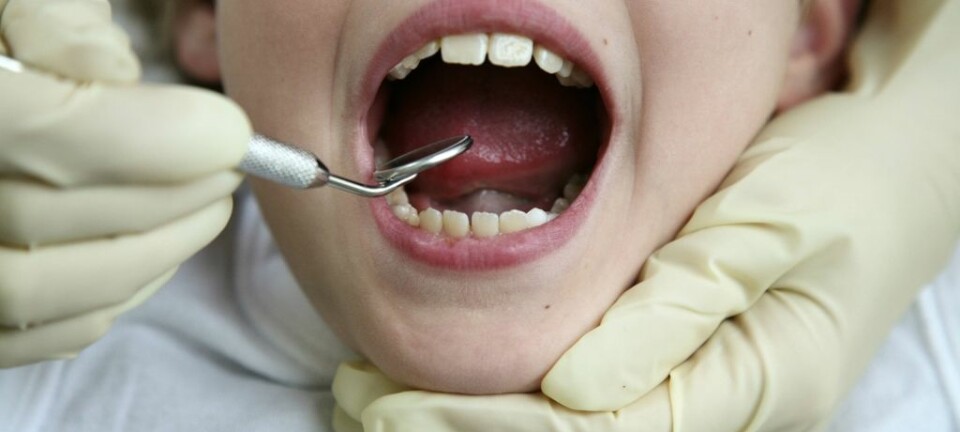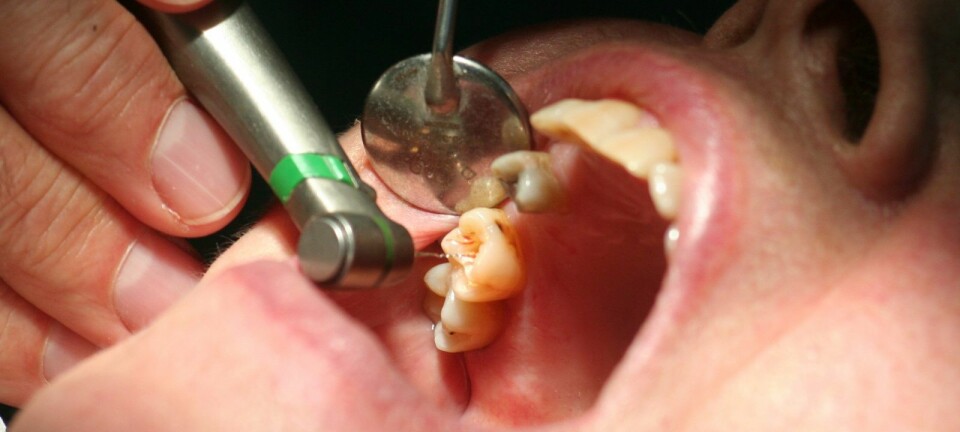
Light is not a bright idea in teeth bleaching
Proof was given back in 2006 that the use of lights as an enhancer in the cosmetic bleaching of teeth was unnecessary and potentially harmful. But dentists are still using teeth-whitening lights.
Denne artikkelen er over ti år gammel og kan inneholde utdatert informasjon.
Whitening teeth at the dentist. The manufacturer of bleaching systems claims a combination of a bleaching compound and light is the most effective. Norwegian researchers scoff at the claim. (Video: denvilledentist/Youtube)
Many Norwegian dentists offer treatment that will give you whiter teeth, but their methods vary.
Some dentists augment bleaching agents with a so-called accelerator light, in some cases this is a laser light, whereas others use the bleaching agent alone.
All boast that their method is the best.

Several advertise that their teeth whitening system has been used in TV series such as “Extreme Makeover”. These shows are from the USA, which is also where most of the cosmetic bleaching systems come from.
Norwegian scientists gave these bleaching systems a thorough investigation six years ago. They concluded that the light used was both unnecessary and possibly harmful.
Dentists we have interviewed say they trust the marketers of bleaching systems, who insist the light treatment is a must. So they continue to use special light when whitening patients’ teeth with bleaching agents. Independent product information is hard to access, as neither bleaching systems nor dental products used in Norwegian mouths are under public control.
Doubling of sales
In 2006 Norwegian researchers at Nordic Institute of Dental Materials (Niom) decided to find out whether such light has any effect in teeth bleaching.
They also observed that this cosmetic whitening of teeth was becoming more in demand. Retailers informed of a doubling in sales of bleaching agents in just a few years. Marketing efforts have been intense and directed at dentists as well as patients.
Niom wanted to study the bleaching systems – the combinations of bleaching compounds and lighting – that were being used in Norway.
No effect
The Niom researchers tested seven bleaching systems, including the so-called Zoom system, which was very popular.
They bleached teeth with and without the use of light. The result was the same; teeth were whitened just as well without the light.
The only effect they registered was that the heat from the lamps made teeth drier, so they looked whiter right then and there.
The researchers reported:
“As there is no clear documentation that light enhances the bleaching result, but could be detrimental to health, we advise against the use of light in teeth bleaching.”
Can injure mucous membranes
After that, no concrete studies of side effects of light have been made in Norway according to Niom.
“It’s more of a risk consideration. Superflous use of light can cause photoallergic reactions,” explains Niom Director and Researcher Jon Dahl.
UV radiation in the bleaching light could harm mucous membranes in the mouth.
Seven years after the Niom study, many Norwegian dentists are still using bleaching light.
Never considered it
Linda Evang is a dentist and owner of a practice on Akersgata in the centre of Oslo.
None of the dentists at her office use lights in connection with cosmetic bleaching.
“We learned from the study that the light had no effect so we have never considered using light in bleaching,” says Evang.
She doesn’t know why others might opt to use it, but says that little is taught about bleaching at dental school.
“Product information and advice is generally issued by the Norwegian Dental Association and HELFO runs courses and issues information,” she adds.
HELFO is the Norwegian Health Economics Administration, a subdivision of the Directorate of Health.
Trusting producers
We have contacted a number of Norwegian dentists who offer bleaching with light as part of the process. None were willing to be interviewed.
The dentists we talked to said they were aware of the Niom report but they choose to trust the manufacturers of the bleaching systems when they say light enhances the result.
Some of these dental offices have web pages which attempt to justify their use lighting systems, for instance that the light makes the bleaching work faster.
Niom Researcher Jon Dahl says that no comparison was made of the time it took to bleach teeth with and without light, but he doubts that it could expedite the process.
“We allowed the same time for bleaching with and without light. You would think if it takes less time with light then teeth would become whiter than when no light was used, since the elapsed time was identical.”
Dental Association: Light probably inessential
The head of communications of the Norwegian Dental Association, Morten H. Rolstad, is also award of the Niom report. It was published in the Association’s journal six years ago.
He hasn’t seen any new research results on the subject and thus presumes there are still grounds for saying the use of special lights is unnecessary in bleaching of teeth.
"But we don't give advice about products," says Rolstad.
“There is no prohibition against using light and perhaps it gives no additional effect,” he adds.
Little independent product information
He offers no opinion about dentists who continue to use light long after it was shown to have no effect but says that it does no harm:
According to Rolstad fewer independent tests of products are being made these days.
“Niom used to have test programmes for materials used in dental treatment but these have nearly come to a standstill. Independent product information is thus less available today than it was earlier.”
“But part of being an academically educated practitioner involves being able to find and evaluate such information yourself,” says Rolstad.
Doubts that producers misguide
Dentists often have to trust product manufacturers.
“Dentists get their information from various producers and suppliers, plus they read professional journals and attend courses.”
“Sellers of equipment and products are well versed in the profession and we have no reason to think they issue misleading information,” says Rolstad.
While new medications have to be approved by the Norwegian Medicines Agency, there is no corresponding public watchdog or organisation assessing products used in dental health.
Rolstad does not think there is any need for such control.
Doesn’t want stronger controls
“Nobody has requested more control, not even the health authorities. No need for more stringent control seems to be required.”
Where can consumers get unbiased information about which kind of dental treatment is the safest and best?
“There are online portals which provide good information to consumers and this is the responsibility of the public health authorities,” says Rolstad.
However, a search using the Norwegian word for teeth bleaching – tannbleking −at the governmental health website gives no hits.
----------------------------
Read the Norwegian version of this story at forskning.no
Translated by: Glenn Ostling
































